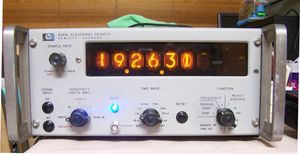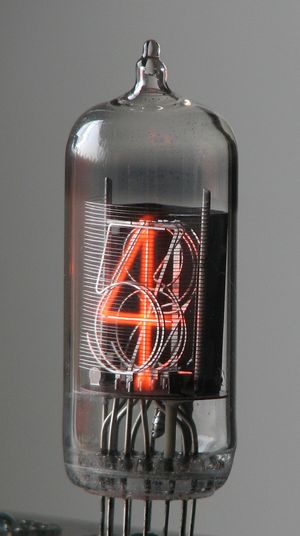Nixie Tubes: Difference between revisions
No edit summary |
No edit summary |
||
| Line 1: | Line 1: | ||
== Nixie Tubes == | == Nixie Tubes == | ||
[[Image:Nixie HP5245L web.jpg|thumb|left|A recent retro project of a digital clock, repurposing an otherwise obsolete unit destined for the re-cycle yard. A heavily modified HP5245L circa 1963 vintage. **Photo copyright IEEE. Clock by David Burger, Sydney.]] | <p>[[Image:Nixie HP5245L web.jpg|thumb|left|A recent retro project of a digital clock, repurposing an otherwise obsolete unit destined for the re-cycle yard. A heavily modified HP5245L circa 1963 vintage. **Photo copyright IEEE. Clock by David Burger, Sydney.]] </p> | ||
The nixie tube is a gas discharge [[Electron (or Vacuum) Tubes|vacuum]] tube, used as a display for numeric and other symbols. The term 'nixie' is actually a trademark of the Burroughs Corporation that has now become a generic name. It was widely used as test equipment display's in the 1950's and early 1960's, as well as calculators, measurement readouts and other instrumentation. | <p>The nixie tube is a gas discharge [[Electron (or Vacuum) Tubes|vacuum]] tube, used as a display for numeric and other symbols. The term 'nixie' is actually a trademark of the Burroughs Corporation that has now become a generic name. It was widely used as test equipment display's in the 1950's and early 1960's, as well as calculators, measurement readouts and other instrumentation. </p> | ||
In recent years there has been a groundswell of retro electronic builders using these as digital clocks, wrist watches, retro [[Compact Discs (CDs)|CD players]] and even punked up [[Radio|AM radio receivers]]. | <p>In recent years there has been a groundswell of retro electronic builders using these as digital clocks, wrist watches, retro [[Compact Discs (CDs)|CD players]] and even punked up [[Radio|AM radio receivers]]. </p> | ||
Nixies | <p>[[Image:Nixie_tube.jpg|thumb|right|Nixie tube Telefunken ZM1210 (without coating) operating. Diameter: 19mm, digits' height: 15,5mm. The filament in front of the digits is the anode. The tube has eleven cathodes: ten of them formed as the digits 0 to 9 and one (in the lower left) as decimal point.]]Nixies display elements operate typically with approx 1mA of current from a 170v DC supply, much in the same approach as basic neon lights. They range in size from miniature (approx 8mm) to extra large (100mm) figure sizes. </p> | ||
A nixie tube display system was used in the year 2000 movie by Warnerbros titled "The Dish". The movie mockup control display using nixies is now on display in the Parkes Radioastronomy centre visitors centre. | <p>A nixie tube display system was used in the year 2000 movie by Warnerbros titled "The Dish". The movie mockup control display using nixies is now on display in the Parkes Radioastronomy centre visitors centre. </p> | ||
[[Category:Components,_circuits,_devices_&_systems|Category:Components,_circuits,_devices_&_systems]] [[Category:Electronic_components]] [[Category:Transducers]] [[Category:News]] | <p>[[Category:Components,_circuits,_devices_&_systems|Category:Components,_circuits,_devices_&_systems]] [[Category:Electronic_components]] [[Category:Transducers]] [[Category:News]]</p> | ||
Revision as of 17:03, 23 July 2010
Nixie Tubes
The nixie tube is a gas discharge vacuum tube, used as a display for numeric and other symbols. The term 'nixie' is actually a trademark of the Burroughs Corporation that has now become a generic name. It was widely used as test equipment display's in the 1950's and early 1960's, as well as calculators, measurement readouts and other instrumentation.
In recent years there has been a groundswell of retro electronic builders using these as digital clocks, wrist watches, retro CD players and even punked up AM radio receivers.
Nixies display elements operate typically with approx 1mA of current from a 170v DC supply, much in the same approach as basic neon lights. They range in size from miniature (approx 8mm) to extra large (100mm) figure sizes.
A nixie tube display system was used in the year 2000 movie by Warnerbros titled "The Dish". The movie mockup control display using nixies is now on display in the Parkes Radioastronomy centre visitors centre.

